We have given these Class 12 Biology Important Questions Chapter 3 Human Reproduction to solve different types of questions in the exam. Go through these Class 12 Biology Chapter 3 Important Questions, Human Reproduction Important Questions & Previous Year Questions to score good marks in the board examination.
Class 12 Biology Chapter 3 Important Questions Human Reproduction
Question 1.
Why are human testes located outside the abdominal cavity? Name the pouch in which they are present. (all India 2014)
Answer:
Human testes are located outside the abdominal cavity as it helps in maintaining low temperature (2-2.5%) lower than body temperature) required for spermatogenesis.
Testes are enclosed in a pouch called scrotum.
![]()
Question 2.
Write the location and functions of following in human testes
(i) Sertoli cells
(ii) Leydig cells (All India 2014)
Or
Name the cells that nourish the germ cells in the testes. Where are these cells located in the testes? (All India 2013C)
Answer:
(i) Location of Sertoli cells Within the lining of seminiferous tubule of testis.
Function of Sertoli cells They provide nutrition to the developing sperms or germ cells.
the
Question 3.
Write the function of the seminal vesicle. (Delhi 2012)
Answer:
Seminal vesicle produces an alkaline secretion containing prostaglandins, proteins and fructose. The high fructose content provides energy to the spermatozoa. These secretions form 60-70% of the fluid found in the semen.
Question 4.
List the different parts of human oviduct through which the ovum travels till it meets the sperm for fertilisation. (Delhi 2014C)
Answer:
The different parts of human oviduct through which the ovum travels, till it gets fertilised are given below in the sequence
- Fimbriae, finger-like projections Collect the ovum from ovary after ovulation.
- Infundibulum Ovum from fimbriae is guided into funnel-shaped infundibulum, part of Fallopian tube.
- Ampulla A wider part of oviduct that leads ovum into isthmus.
- Isthmus It has a narrow lumen which opens into uterus. In the junction of ampulla- isthmus, the ovum gets fertilised.
Question 5.
Draw a labelled diagram to show inter-relationship of four accessory ducts in a human male reproductive system. (Delhi 2019)
Answer:
Refer to figure 3.1 (b) on page no. 48.
Question 6.
The below diagram shows human male reproductive system (one side only).
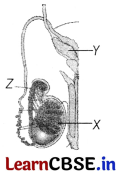
(i) Identify ‘X’ and write its location in the body.
(ii) Name the accessory gland ‘Y’ and its secretion.
(iii) Name and state the function of ‘Z’. (Delhi 2015C)
Answer:
(i) .X-Testis. It is located outside the abdominal cavity within a pouch called scortum.
(ii) K-Seminal vesicle. It produces an alkaline secretion rich in fructose and constitutes 60% of the volume of the semen.
(iii) Z-Epididymis. It stores the sperms and secretes a fluid which helps in the maturation of sperms.
Question 7.
(i) Draw a labelled diagrammatic view of human male reproductive system,
(ii) Differentiate between vas deferens and vasa efferentia. (Delhi 2014)
Answer:
(i) Refer to figure 3.1 on page no. 48.
(ii) Distinction between vas deferens and vasa efferentia
| Vas deferens | Vasa efferentia |
| It is a tube-like structure which conducts the spermatozoa from the epididymis to the penis. | It connects the rete testis to the epididymis. |
| They arise from the rete testis. | They arise from the cauda epididymis. |
| They are only 2 in number. | They vary from 15-20 in number. |
| Vas deferens are thick. | Vasa efferentia are fine. |
| Their lining has many stereocilia. | Their lining bears many ciliated cells. |
Question 8.
Name and explain the role of inner and middle walls of human uterus. (Delhi 2014)
Answer:
The innermost wall of uterus is called endometrium.
Role of Endometrium
(i) It lines the uterine cavity and is glandular in nature.
(ii) It undergoes cyclic changes during menstrual cycle.
The middle wall or layer of uterus is called myometrium.
Role of Myometrium
(i) It is made up of thick layer of smooth muscles.
(ii) It shows strong contractions during the delivery of baby.
Question 9.
Draw a labelled diagram of reproductive system in a human female. (All India 2011)
Answer:
Refer to figure 3.2 on page no. 49.
Question 10.
When do the oogenesis and the spermatogenesis initiate in human females and males, respectively? (Delhi 2012)
Answer:
Oogenesis initiates during foetal or embryonic stage in females, whereas spermatogenesis in males starts at puberty.
Question 11.
Mention the differences between spermiogenesis and spermiation. (Delhi 2012)
Answer:
Difference between spermiogenesis and spermiation is
| Spermiogenesis | Spermiation |
| It is the process of transforming spermatids into mature spermatozoa or sperms through differentiation. | Sperm heads are embedded in Sertoli cells to obtain nourishment and finally released from seminiferous tubules by the process called spermiation. |
Question 12.
Where is acrosome present in humans? Write its function. (All India 2012)
Answer:
In humans, the acrosome is present in the anterior portion of the head of human sperm. Function Hydrolytic enzymes or sperm lysins present in acrosome help in the penetration of sperm into egg, during fertilisation.
![]()
Question 13.
List the changes the primary oocyte undergoes in the tertiary follicular stage in human embryo. (Foreign 2011)
Answer:
The primary oocyte within the tertiary follicle grows in size. The fully grown primary oocyte completes its first meiotic division to produce two daughter nuclei in which larger haploid cell is called secondary oocyte and the tiny one is called first polar body. The secondary oocyte retains bulk of nutrient ricfi cytoplasm of primary oocyte. (1)
Question 14.
Draw a sectional view of human ovary showing the different stages of developing follicles, corpus luteum and ovulation. (Delhi 2019)
Or
(i) Draw a sectional view of human ovary and label the following parts
(a) Primary follicle
(b) Secondary oocyte
(c) Graafian follicle
(d) Corpus luteum
(ii) Name the hormones influencing follicular development of corpus luteum. (All India 2019)
Answer:
Refer to figure 3.6 on page no. 53.
The hormones influencing follicular development of corpus uteum are FSH, oestrogen and progesterone.
Question 15.
Explain the role of pituitary and sex hormones in the process of spermatogenesis. (All India 2015C)
Or
Spermatogenesis in human males is a hormone regulated process. Justify. (Delhi 2014)
Or
Explain the hormonal regulation of the process of spermatogenesis in humans. (All India 2013)
Answer:
Hormonal control of spermatogenesis in human males is as follows
- Gonadotropin Releasing Hormone (GnRH) is released significantly from the hypothalamus during puberty.
- GnRH stimulates anterior pituitary to secrete gonadotropins, i.e. LH and FSH or Interstitial Cell Stimulating Hormone (ICSH).
- Luteinising Hormone (LH) acts on Leydig cells to stimulate the synthesis and secretion of androgens which then stimulate the process of spermatogenesis.
- Follicle Stimulating Hormone (FSH) acts on Sertoli cells and stimulates them to secrete inhibin which then stimulates the process of spermiogenesis.
Question 16.
What happens to corpus luteum in human female if the ovum is (i) fertilised, (ii) not fertilised? (Delhi 2015)
Or
Mention the fate of corpus luteum and its effect on the uterus in the absence of fertilisation of the ovum in human female. (Foreign 2010)
Answer:
- In case of fertilisation, the corpus luteum continues secreting progesterone which is required for the maintenance of endometrium during pregnancy.
- In the absence of fertilisation, the corpus luteum degenerates and gets converted into corpus albicans. Deficiency of progesterone causes disintegration of the endometrium leading to menstruation and thus, a new cycle starts.
Question 17.
Draw a diagram of a mature human sperm. Label any three parts and write their functions.
Or
Draw a labelled diagram of a human sperm. (Foreign 2015, 2011)
Or
Draw a diagram of human sperm. Label only those parts along with their functions that assist the sperm to reach and gain entry into the female gamete. Foreign 2014
Answer:
For structure of a human sperm Refer to figure 3.5 on page no. 52.
The parts that assist sperm to reach and gain entry into female gamete are,
Tail Its wiggling movement helps the sperm to swim in female reproductive tract.
Middle piece It contains mitochondria that provide energy for sperm movement.
Head It contains acrosome loaded with sperm lysins. These help to dissolve the layers of female gamete or egg.
Question 18.
Write the effect of high concentrations of LH on a mature Graafian follicle. (All India 2014)
Answer:
The high concentration of LH (also known as LH surge) induces the rupture of Graafian follicle, which results in the release of secondary oocyte hence, causing ovulation in females.
Question 19.
Differentiate between spermatogenesis and spermiogenesis. (Delhi 2014)
Answer:
Differences between spermatogenesis and spermiogenesis are
| Spermatogenesis | Spermiogenesis |
| It is a process of formation of sperms from immature germ cells. | It is a process of transformation of a circular spermatid to a motile spermatozoa. |
| Number of cells increases as each spermatogonium produces four spermatids. | No change in number of cells as only one spermatid develops into a spermatozoa. |
Question 20.
Draw and label the parts of the head region only of a human sperm. (Delhi 2014C)
Answer:
Diagram showing head of human sperm is given below
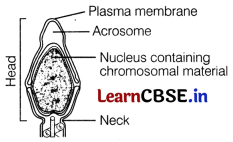
Question 21.
Identify A, B, C and D with reference to gametogenesis in humans, in the flow chart given below. (All India 2012C)
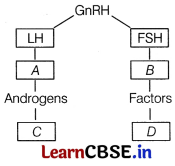
Answer:
A – Leydig’s cell
B – Sertoli cell
C – Spermatogenesis
D – Spermiogenesis
Question 22.
Name the labels A, B, C, D, E and F in the diagram of seminiferous tubule. (Delhi 2011)
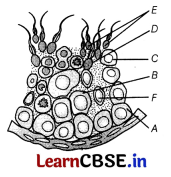
Answer:
In the given diagram,
A – Spermatogonium
B – Primary spermatocyte
C – Secondary spermatocyte
D – Spermatid
E – Spermatozoa
F – Sertoli cell
Question 23.
Differentiate between menarche and menopause. (All India 2010)
Answer:
Differences between menarche and menopause are
| Menarche | Menopause |
| It refers to the beginning of menstrual cycle in human female at puberty. | It refers to the stoppage of menstrual cycle at the age of about 45-50 in human female. |
| It indicates the start of reproductive phase. | It indicates the end of reproductive phase. |
Question 24.
Study the sectional view of human testis showing seminiferous tubules given below.
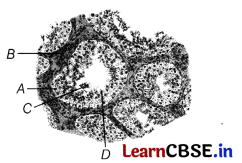
(i) Identify A, B and C.
(ii) Write the function of A and D. (Foreign 2010)
Answer:
(i) A-Spermatogonia
B-Interstitial cells
C-Spermatozoa.
(ii) A-Spermatogonia undergo meiosis to produce spermatozoa (sperms).
D-Sertoli cells provide nutrition to the germ cells.
Question 25.
How and at what stage of menstrual cycle is corpus luteum formed in human females? When does it regress? (Delhi 2010C)
Answer:
After ovulatory phase (ovulation), the luteal phase starts. The remaining parts of ruptured Graafian follicle transform into corpus luteum in this phase. The corpus luteum secretes large amount of progesterone which is essential for the maintenance of endometrium.
scientific
Question 26.
Draw a labelled diagrammatic sectional view of a human seminiferous tubule. (Delhi 2017)
Answer:
Refer to figure 3.3 on page no. 51.
![]()
Question 27.
(i) How many primary follicles are left in each ovary in a human female at puberty?
(ii) Draw a sectional view of the ovary showing the different follicular stages of a human female in her preovulatory phase of menstrual cycle. (Outside Delhi 2016C)
Answer:
(i) A large number of primary follicles degenerate in females during the period from birth to puberty by the process called follicular atresia. As a result, about 60000-80000 primary follicles are left in each ovary at puberty.
understanding
Question 28.
Explain the events in a normal woman during her menstrual cycle on the following days (Delhi 2015C)
(i) Ovarian event from 13-15 days.
(ii) Ovarian hormones level from 16-23 days.
(iii) Uterine events from 24-29 days.
Answer:
(i) In the ovarian event from 13-15 days, a immature ovum (egg cell) is released from the Graafian follicle. Both LH and FSH attain maximum peak. FSH helps Graafian follicle to attain maturity and LH helps in its rupture. Ovum covered by a number of layer and a yellow fat layer forms corpus luteum. It releases (secretes) progesterone.
of
the
Question 29.
Explain the events in a normal woman during her menstrual cycle on the following days (All India 2015C, Outside Delhi 2015C)
(i) Pituitary hormone levels from 12 days.
(ii) Uterine events from 13-15 days.
(iii) Ovarian events from 16-23 days.
Answer:
(i) The period of 8-12 days after the onset of menstruation is the follicular phase. During this phase, GnRH from hypothalamus stimulates anterior pituitary to release FSH and LH. FSH stimulates the ovarian follicles to secrete oestrogen, which in turn stimulates the proliferation of the endometrium of the uterine wall. This causes the endometrial lining to thicken.
menstrual
(iii) During 16-23 days, ruptured Graafian follicle gets converted into corpus luteum in the pvary.
It starts secreting progesterone which maintains the endometrium, necessary for the implantation of fertilised ovum followed by other events of pregnancy.
Question 30.
Explain the hormonal control of spermatogenesis in humans. (Foreign 2014)
Answer:
Refer to Answer No. 6. (3)
Question 31.
Explain the steps in the formation of an ovum from oogonium in humans. (All India 2013)
Answer:
In human females, primary oocytes are formed from the oogonia during the embryonic developmental stages in the foetal ovaries.
- Oogonial cells start dividing and enter prophase-I of meiosis. They remain suspended at this stage as primary oocytes.
- Each primary oocyte is surrounded by a layer of granulosa cells and becomes the primary follicle.
- The primary follicle when surrounded by more layers of granulosa ceils, is called a secondary follicle.
- Secondary follicle transforms into a tertiary follicle, with the development of a fluid-filled cavity (antrum) around the primary oocyte
- Granulosa cells become organised into an outer theca externa and an inner theca interna.
- Now, primary oocyte completes meiosis-I and forms a larger haploid secondary oocyte and a tiny first polar body.
- Tertiary follicle grows and becomes a mature follicle called Graafian follicle.
- Secondary oocyte secretes a new membrane called zona pellucida around it.
- At this stage, follicle ruptures to release the secondary oocyte, which moves into the cytoplasm.
- Secondary oocyte completes meiosis-II only when a sperm enters its cytoplasm. It forms a larger cell, the ootid and a small pell, the second polar body. This event occurs in the ampulla of Fallopian tube.
Question 32.
(i) Explain menstrual cycle in human females.
(ii) How can the scientific understanding of the menstrual cycle of human females help as a contraceptive measure ? (2018)
Answer:
(i) Menstrual Cycle The inner lining of uterus called endometrium, grows and thickens each month and prepares itself for the implantation of an embryo. If tht) pregnancy does not occur, the endometriumisheds off. The monthly development and shedding of the functional layer of the uterus is called the menstrual phase and the monthly maturation of an egg and its release is called the ovarian cycle. A typical menstrual cycle completes in an average of about. 28 days. It starts at the age of 13 or 15 and continues till about 50 years of age. Menstrual cycle occurs in three major phases namely menstrual phase, follicular phase and secretory phase.
(a) Menstrual Phase It lasts for 3-4 days. It occurs due to the breakdown of endometrium lining cf uterus and blood vessels.
(b) Follicular Phase or Proliferative Phase. It is regulated by the hormones secreted by anterior pituitary gland whose secretions stimulate the ovarian follicle to secrete oestrogens.
cycle
(c) Secretory Phase or Luteal phase The phase of menstrual cycle with possibility of fertilisation is the initial luteal phase. It is marked by the presence of corpus luteum (yellow body). During pregnancy, this yellow body secretes progesterone. In the absence of pregnancy, it regresses to form corpus albicans and menstruation starts (menstrual phase). Due to the hormones secreted by corpus luteum, i.e. oestrogen and progesterone, the release of FSH and LH is inhibited. This prevents the development of new follicles.
This phase lasts for 14 days.
of
human
Question 33.
(i) Arrange the following hormones in the sequence of their secretion in a pregnant woman. hCG, LH, FSH, Relaxin
(ii) Mention their source and the function they perform. (Delhi 2017)
Answer:
(i) The sequence of secretion of the given hormones in a pregnant woman is
FSH → LH → hCG → Relaxin
| Hormone | Source | Function |
| FSH | Anterior pituitary lobe | Stimulates the growth of ovarian follicles in ovary. |
| LH | Anterior pituitary lobe | It triggers ovulation. |
| hCG | Placenta | It stimulates the corpus luteum to secrete progesterone. |
| Relaxin | Placenta | It facilitates parturition by softening the connective tissue of symphysis pubica. |
Question 34.
(i) Explain the menstrual phase in a human female. State the level of ovarian and pituitary hormones during this phase.
(ii) Why is follicular phase in the menstrual cycle also referred as proliferative phase? Explain.
(iii) Explain the events that occur in a Graafian follicle at the time of ovulation and thereafter.
(iv) Draw a Graafian follicle and label antrum and secondary oocyte. (Delhi 2016)
Answer:
(i) The reproductive cycle in female primates, e.g. monkeys, apes and human beings is called menstrual cycle.
Menstrual phase starts from 3rd day and ends on 5th day of the menstrual cycle. It is initiated due to the reduced secretion of progesterone and oestrogen from the regressing corpus luteum in the ovary. The endometrium breaks down and blood along with degenerated ovum constitutes the menstrual flow. The secretion of pituitary hormones, i.e. FSH and LH is also reduced during this phase.
females
(iii) Graafian Follicle at Ovulation:
At the time of ovulation following events occur
- LH and FSH reach at their peak levels (about 14th-16th day of cycle).
- High level of LH induces Graafian follicle to rupture and the release of secondary oocyte from it.
- After ovulation, the remaining cells of Graafian follicle are stimulated by LH to develop corpus luteum (an endocrine gland which secrete progesterone hormone).
(iv) Diagrammatic sectional view of Graafian follicle
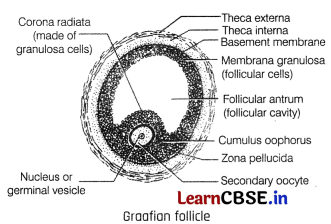
Question 35.
(i) Explain the process of spermatogenesis in humans.
(ii) Draw a human sperm and label acrosome and middle piece. Mention their functions. Outside (Delhi 2016C)
Answer:
(i) Spermatogenesis is the production of sperms in males.
- In testis, the immature male germ cells (spermatogonia) produce sperms by spermatogenesis. It begins at puberty due to significant increase in the secretion of gonadotropins, i.e. luteinising hormone and follicle stimulating hormone under the influence of Gonadotropin Releasing Hormone (GnRH) released from hypothalamus.
- Spermatogonia (sing, spermatogonium) present on the inside wall of seminiferous tubules multiply by mitotic division and increases in numbers.
- Each spermatogonium is diploid and contains 46 chromosomes. Some of the spermatogonia transform to primary spermatocytes.
- The primary spermatocyte undergoes meiosis -1 and forms two haploid secondary spermatocytes containing 23 chromosomes each.
- The secondary spermatocytes undergo meiosis – II and form four equal sized haploid spermatids.
- Spermatids transform into the spermatozoa by spermiogenesis.
- After spermiogenesis, the sperm heads get embedded in the Sertoli cells and released from the seminiferous tubules via spermiation process.
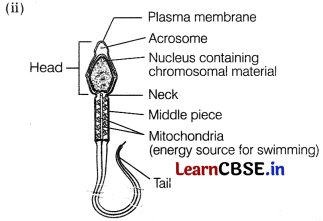
(a) The acrosome is filled with hydrolytic enzymes that help the sperm to penetrate the ovum.
(b) Middle piece possesses many mitochondria to produce energy for the movement of tail to facilitate sperm motility.
Question 36.
Describe the roles of pituitary and ovarian hormones during the menstrual cycle in a human female. (Delhi 2015)
Or
Explain the ovarian and uterine events that occur during a menstrual cycle in a human female under the influence of pituitary and ovarian hormones, respectively. (Delhi 2014)
Or
Explain the different phases of menstrual cycle and correlate the phases with the different levels of pituitary hormones in a human female. (Delhi 2014C)
Or
With the help of graphical illustration only, show the changes in the levels of the pituitary hormone during menstrual cycle in humans. (Delhi 2011C)
Answer:
The cycle of events starting from one menstruation till next in female primates is called menstrual cycle. It comprises of four phases which are regulated by both pituitary (LH and FSH) and ovarian (oestrogen and progesterone) hormones that affect ovaries and uterus, respectively. The events occurring in a menstrual cycle are as follows
| Menstrual phase (from 3rd-5th day in a 28 day cycle) | Initiated by reduced secretion of LH, progesterone and oestrogen. The endometrium breaks down and blood along with unfertilised ovum constitutes menstrual flow. |
| Follicular phase (from 6th-13th day in a 28 day cycle) | The FSH (Follicle Stimulating Hormone) secreted by anterior pituitary stimulates ovarian follicle to secrete oestrogens. These oestrogens stimulate proliferation of uterine walls as a result of which endometrium gets thickened (due to rapid cell division and increase in uterine glands and blood vessels). |
| Ovulatory phase (14th day in 28 day cycle) | Pituitary hormones, i.e. LH and FSH reach the highest level in middle of the cycle. Rapid secretion of LH causes ovulation thus, inducing the rupture of Graafian follicle to release secondary oocyte and a polar body. |
| Luteal or secretory phase (from 15th-28th day in a 28 day cycle) | The pituitary hormone LH stimulates the remaining cells of ovarian follicles to develop into corpus luteum. This corpus luteum secretes large amount of progesterone and maintains endometrium thickening for the implantation of fertilised ovum during pregnancy. In the absence of fertilisation, the hormone levels are reduced (LH and progesterone) and endometrium disintegrates leading to onset of another menstrual cycle. |
For graphical illustration of menstrual cycle;
Refer to figure 3.J0 on page no. 55.
![]()
Question 37.
Explain the development of a secondary oocyte (ovum) in a human female from the embryonic stage up to its ovulation. Name the hormones involved in this process. (Delhi 2015)
Or
When and where are primary oocytes formed in a human female? Trace the development of these oocytes till ovulation (in menstrual cycle). How do gonadotropins influence this developmental process? (Delhi 2010)
Answer:
Embryonic Stages Refer to Answer No. 22.
Influence of Gonadotropins on Oogenesis:
- Gonadotropins, i.e., LH and FSH stimulate follicular development and secretion of oestrogen by the growing follicles.
- Both LH and FSH attain a peak level in the middle of the cycle (14th day).
- Rapid release of LH during mid-cycle causes ovulation.
- LH also stimulates the formation of corpus luteum from the ruptured follicle and secretion of progesterone from corpus luteum.
Question 38.
(i) How is ‘oogenesis’ markedly different from ‘spermatogenesis’ with respect to the growth till puberty in the humans?
(ii) Draw a sectional view of human ovary and label the different follicular stages, ovum and corpus luteum. (Delhi 2014)
Answer:
(i) Oogenesis is markedly different from spermatogenesis in the following aspects
| Spermatogenesis | Oogenesis |
| It occurs in males. starting from puberty till the complete life cycle. | It starts before birth during embryonic development and occurs till menopause. |
| A single spermatogonium after second meiotic division forms four haploid sperrftatids that mature to form four spermatozoa. | A single oogonium, after second meiotic division, produces one ovum and two non-functional polar bodies. |
| The process of spermatogenesis, i.e. second meiotic division completes in testes and releases mature sperms. | The second meiotic division of oogenesis completes in Fallopian tube when sperm enters the secondary oocyte. |
helps
Question 39.
Schematically represent and explain the events of spermatogenesis in humans. (Delhi 2014C)
Answer:
Refer to Answer No. 26 (i)
Question 40.
(i) Draw a transverse section of a human ovary showing the sequential development of different follicles up to the corpus luteum.
(ii) Comment on the corresponding ovarian and pituitary hormone levels during these events. (Delhi 2014C)
Answer:
(i) Refer to figure 3.6 on page no. 53.
(ii) Refer to Answer No. 28.
Question 41.
The following is the illustration of the sequence of ovarian events (A-I) in a human female.
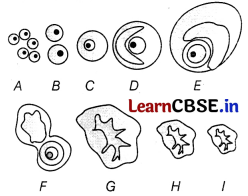
(i) Identify the figure that illustrates ovulation and mention the stage of oogenesis it represents.
(ii) Name the ovarian hormone and the pituitary hormone that have caused the above mentioned event.
(iii) Explain the changes that occur in the uterus simultaneously in anticipation.
(iv) Write the differences between C and H.
(v) Draw a labelled sketch of the structure of a human ovum prior to fertilisation. (Delhi 2012)
Answer:
(i) Figure F illustrates ovulation. It represents the ovulatory stage of oogenesis.
(ii) Ovarian and pituitary hormones involved in causing ovulation are
Ovarian hormone Oestrogen.
Pituitary hormone LH and FSH.
(iii) In anticipation of receiving the fertilised egg, the endometrium of the uterus gets thickened and also the blood supply to the endometrium increases.
(iv) In the figure, C stage represents the secondary follicle and the H stage represents the degenerating corpus luteum.
| Secondary follicle | Corpus luteum |
| It is surrounded by layers of granulosa cells and theca layer. | Layers of granulosa cells and theca cells are absent. |
| It contains an oocyte | It does not contain oocyte as it is formed after the release of secondary oocyte. |
| It does not secrete | It secretes progesterone. |
(v) Structure of a human ovum
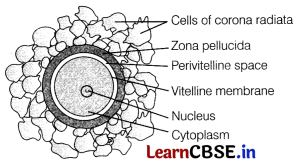
Question 42.
The following is the illustration of the sequence of ovarian events A-I in a human female.
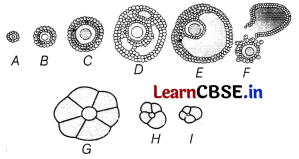
Identify the figure that illustrates corpus luteum and name the pituitary hormone that influences its formation.
(ii) Specify the endocrine function of corpus luteum. How does it influence the uterus? Why is it essential?
(iii) What is the difference between D and E?
(iv) Draw a neat and labelled sketch of Graafian follicle. (Delhi 2012)
Answer:
(i) Gis corpus luteum. LH secreted by anterior pituitary’ influences its formation.
(ii) The endocrine function of corpus luteum is to secrete progesterone which is essential for the maintenance of endometrium layer of uterus. Thickened endometrium is necessary for the implantation of fertilised ovum and other events of pregnancy.
(iii) D is a developing secondary follicle containing primary oocyte and undifferentiated thecal cells. E is a mature tertiary follicle that contains a secondary oocyte and differentiated theca cells.
(iv) Structure of a Graafian follicle
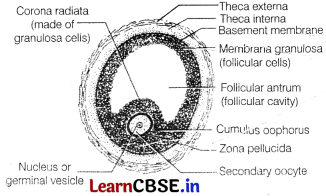
Question 43.
(i) Describe the stages of oogenesis in human females.
(ii) Draw a labelled diagram of a human ovum released after ovulation. (Delhi 2012)
Answer:
(i) For oogenesis, Refer to Answer No. 22.
(ii) Human ovum Refer to Answer No. 32 (v).
Question 44.
(i) Draw a diagrammatic labelled sectional view of a seminiferous tubule of a human.
(ii) Describe in sequence the process of spermatogenesis in humans.
Answer:
(i) Sectional view of a seminiferous tubule
Refer to figure 3.3 on page no. 51.
(ii) Refer to Answer No. 26 (i).
Question 45.
State from where do the signals for parturition originate in human females. (All India 2019)
Answer:
Foetal-ejection reflex generated by fully developed foetus and placenta stimulates pituitary to release the hormone oxytocin responsible for parturition.
![]()
Question 46.
Mention the function of zona pellucida. (Delhi 2015C, 2013)
Answer:
During (ertilisation, a sperm comes in contact with the zona pellucida layer of ovum and induces changes in the membrane and forms fertilisation envelope. It helps block the entry of additional sperms. So, zona pellucida ensures that only one sperm fertilises an ovum.
Question 47.
How does the sperm penetrate through the zona pellucida in human ovum? (Delhi 2013C)
Answer:
The sperm penetrates through the zona pellucida by releasing sperm lysins (hyaluronidase and protease) present in the acrosome.
Question 48.
How is the entry of only one sperm ensured into an ovum during fertilisation in humans? (All India 2012)
Answer:
Presence of zona pellucida layer ensures that only one sperm can fertilise an ovum.
Refer to Answer No. 2.
Question 49.
Write the function of oxytocin. (Delhi 2012)
Answer:
Oxytocin secreted by posterior pituitary helps in parturition by inducing and enhancing uterine muscle contractions.
Question 50.
Mention the function of trophoblast in human embryo. (Delhi 2011)
Answer:
Trophoblast is the outer layer of blastocyst which helps in the attachment of blastocyst to the endometrium of the uterus.
Question 51.
Name the embryonic stage that gets implanted in the uterine wall of a human female. (All India 2011)
Answer:
Blastocyst gets implanted in the uterine wall of human female.
Question 52.
What stimulates pituitary to release the hormone responsible for parturition? Name the hormone. (All India 2011)
Answer:
Foetal-ejection reflex stimulates pituitary to release the hormone responsible for parturition. This hormone is oxytocin.
Question 53.
Why is breastfeeding recommended during the initial period of an infant’s growth? Give reasons. (Delhi 2016)
Or
(i) Why is mother’s milk considered very essential for the healthy growth of infants?
(ii) What is the milk called that is produced in the initial days of lactation? (All India 2016)
Answer:
The first milk which comes out from the mother’s mammary glands just after childbirth is called colostrum. This is a thin, yellowish, opalescent fluid.
as
Question 54.
Where does fertilisation occur in humans? Explain the events that occur during this process. (All India 2014)
Or
Explain the events that occur during fertilisation of an ovum in humans. How is it that only one sperm enters the ovum? (All India 2014C)
Answer:
In humans, the fertilisation of ovum takes place in ampullary-isthmic junction of the Fallopian tube.
The events that occur during the process of fertilisation are
- The sperm reaches the junction of ampulla and isthmus and comes in contact with zona pellucida layer of ovum.
- Acrosome of sperm head releases sperm lysin enzyme that dissolves corona radiata and digests zona pellucida layer to enter the cytoplasm of ovum.
- After the entry of sperm into the ovum, zona pellucida induces changes in membrane and blocks the entry of additional sperms
- Entry of sperm stimulates the secondary oocyte to complete its suspended second meiotic division thus, producing haploid egg or ovum and second polar body.
- Nucleus of sperm and of ovum fuse to form a diploid zygote.
Question 55.
When and where do chorionic villi appear in humans? State their function. (Delhi 2013)
Answer:
After implantation in the uterus, finger-like projections called chorionic villi appear on the trophoblast of blastocyst. It interdigitates with uterine tissue to form placenta that transports oxygen and nutrients to foetus and remove waste products and carbon dioxide produced by the foetus.
Question 56.
(i) Where do the signals for parturition originate in humans?
(ii) Why is it important to feed the newborn babies on colostrum? (All India 2012)
Answer:
(i) The signals for parturition originate from the fully developed foetus and the placenta, which induces mild uterine contraction called foetal-ejection reflex.
(ii) Colostrum contains necessary antibodies (IgA) that provide protection against disease to infants.
Question 57.
Explain the function of umbilical cord. (All India 2012)
Answer:
The placenta is connected to developing embryo through an umbilical cord, which helps in the transport of substances like oxygen, nutrients, etc. to and from the developing embryo. Blood in umbilical cord can be collected during delivery and stored to treat various diseases in future because it is rich in stem cells.
Question 58.
Mention the number of cells in the following stages.
| Embryonic Stage | Number of Cells |
| Zygote | (i) |
| Morula | (ii) |
| Blastocyst | (iii) |
Answer:
(i) 1 (ii) 16 (iii) 64 (2)
Question 59.
Name the hormones produced only during pregnancy in human female. Mention their source organs. (Foreign 2011)
Answer:
The hormones produced only during pregnancy in human female are human Chorionic and placenta Gonadotropin (hCG), human Placental Lactogen (hPL) and relaxin.
The source of hCG and hPL is placenta and that of relaxin is ovary and placenta.
![]()
Question 60.
Why is parturition called a neuroendocrine mechanism? (All India 2011C)
Answer:
Process of parturition is induced by both neural system and endocrine system therefore, it is called a neuroendocrine mechanism.
Vigorous contraction of the uterus at the end of pregnancy causes expulsion/delivery of the foetus. The process of delivery of foetus (childbirth) is called parturition.
Relaxin hormone is secreted by the ovary and placenta to facilitate parturition by softening the connective tissue of symphysis pubica. Foetus and the placenta induce mild uterine contractions called foetal-ejection reflex.
This initiates the release of oxytocin hormone from the posterior pituitary. Oxytocin acts on uterine muscles to cause stronger contractions, which in turn stimulate further secretion of oxytocin.
This causes more stronger contractions leading to the expulsion of the baby out of the uterus, through the birth canal. After the baby is delivered, the placenta is also expelled out of the uterus.
Question 61.
(i) Explain the process of fertilisation in human.
(ii) Name the embryonic stage that gets implanted in human females. Explain the process of implantation. (Delhi 2019)
Answer:
(i) Refer to Answer No. 23 (i). (3)
(ii) Blastocyst gets implanted in the uterine wall.
Process of implantation, Refer to Answer No. 23 (i).
Question 62.
The given diagram shows a part of the human female reproductive system.
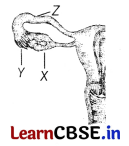
(i) Name the gamete cells that would be present in X’ if taken from a newborn baby.
(ii) Name ‘Y’ and write its function.
(iii) Name ‘Z’ and write the events that take place here. (All India 2015C)
Answer:
(i) Primary oocytes are present in A, i.e. ovary of a newborn baby.
(ii) Y is fimbriae. It helps in the collection of ovum from ovary after ovulation.
(iii) Z is the ampullary-isthmic junction. It is the site of fertilisation in humans.
Question 63.
Describe the process of parturition in human. (Delhi 2015)
Answer:
Refer to Answer No. 16
Question 64.
(i) How is placenta formed in human female?
(ii) Name any two hormones which are secreted by it and are also present in a non-pregnant woman. (Foreign 2014)
Answer:
(i) After implantation of blastocyst, the finger-like projections called chorionic villi, appear on the trophoblast. They get surrounded by uterine tissue and maternal blood which become interdigitated with each other to form placenta.
(ii) The two hormones secreted by placenta that are also present in a non-pregnant woman are oestrogen and progesterone.
Question 65.
Given below is the diagram of a human ovum surrounded by a few sperms. Study the diagram and answer the following questions.
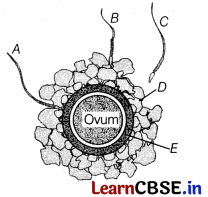
(i) Which one of the sperms would reach the ovum earlier?
(ii) Identify ‘D and ‘E. Mention the role of ‘E.
(iii) Mention what helps the entry of sperm into the ovum and write the changes occurring in the ovum during the process.
(iv) Name the specific region in the female reproductive system where the event represented in the diagram takes place. (All India 2019)
Answer:
(i) The sperm ‘A’ would reach the ovum earlier.
(ii) D-Cororia radiata, E-Zona pellucida-During fertilisation, a sperm comes in contact with zona pellucida layer of the ovum and induces changes in the membrane that block the entry of additional sperms. Hence, E helps to prevent polyspermy.
(iii) The hydrolytic secretions of the acrosome help the sperm to enter into the cytoplasm of the ovum through the zona pellucida and the plasma membrane. This induces the completion of the meiotic division of the secondary oocyte.
(iv) These events take place in the ampullary-isthmic junction of the Fallopian tube of uterus.
Question 66.
(i) Draw a diagram of the adult human female reproductive system and label the different
(a) parts of Fallopian tube
(b) layers of uterus wall
(ii) Explain the events during fertilisation of an ovum in humans.
Answer:
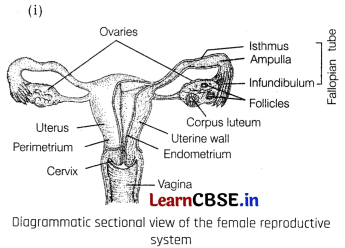
(ii) Refer to Answer No. 23 (i).
Question 67.
Briefly explain the events of fertilisation and implantation in an adult human female.
(ii) Comment on the role of placenta as an endocrine gland. (Delhi 2016)
Or
Explain the process of fertilisation and implantation in human. (Foreign 2015)
Answer:
(i) Fertilisation is the process of fusion of a sperm with an ovum.
- The motile sperms move through the cervix’, enter the uterus and reach the junction of the isthmus and ampulla (ampullary-isthmic junction) of the Fallopian tube.
- The ovum released from the ovary also reaches the ampullary-isthmic junction where fertilisation takes place.
- Fertilisation can only occur if the ovum and sperms are transported simultaneously to this junction. This explains why all copulations do not lead to fertilisation and pregnancy.
- The sperm comes in contact with the zona pellucida of the ovum and releases sperm lysins which induces changes in the egg membrane. It blocks the entry of the other sperms into the egg. Thus, it ensures that only one sperm can fertilise an ovum.
- The secretions of the acrosome help the sperm to enter into the cytoplasm of the ovum through the zona pellucida and the plasma membrane.
- This induces the completion of meiotic division of the secondary oocyte. The secondary meiotic division results in the formation of a secondary polar body and a haploid ovum (ootid).
- The haploid nucleus of the sperm and that of ovum fuse together to form a diploid zygote.
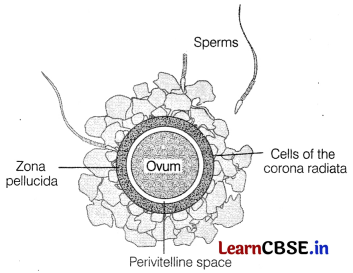
a
- The embryo with 8-16 blastomeres is called morula. But, it is not larger than a zygote.
- The morula continues to divide and transforms into blastocyst as it moves further into the uterus.
- The blastomeres in the blastocyst gets arranged into an outer layer called trophoblast and the inner group of cells attached to trophoblast called the inner cell mass.
- The trophoblast layer then gets attached to the endometrium and the inner cell mass differentiates into the embryo. After attachment, the uterine cells divide rapidly and cover the blastocyst.
contraceptive
(ii) Placenta also acts as an endocrine tissue and produces several hormones like human Chorionic Gonadotropin (hCG), human Placental Lactogen (hPL) oestrogen, progesterone, etc.
The hCG stimulates and maintains corpus luteum to secrete progesterone. hPL stimulates the growth of mammary glands during pregnancy. Relaxin helps in parturition by softening the connective tissue of pubic symphysis.
![]()
Question 68.
During the reproductive cycle of a human female when, where and how does placenta develop? What is the function of placenta during pregnancy and embryo development? (Delhi 2015)
Answer:
Placenta is an organ that connects the developing foetus to the uterine wall of mother for supporting pregnancy.
method
.
- It facilitates the supply of oxygen and nutrients to the developing embryo.
- It also facilitates the removal of carbon dioxide and waste materials produced by the foetus.
- The placenta is connected to the developing embryo through the umbilical cord, which helps in the transport of substances to and from the developing embryo.
- Placenta also acts as an endocrine tissue and produces several hormones like human Chorionic Gonadotropin (hCG), human Placental Lactogen (hPL), oestrogen, progesterone, etc.
ii)
Question 69.
(i) Explain the events taking place at the time of fertilisation of an ovum in a human female.
(ii) Trace the development of the zygote up to its implantation in the uterus.
(iii) Name-and draw a labelled sectional view of the embryonic stage that gets implanted. (Delhi 2010)
Answer:
(i) Refer to Answer No. 23 (i).
(ii) Refer to Answer No. 23 (i).
(iii) Blastocyst is the stage implanted in the uterus.
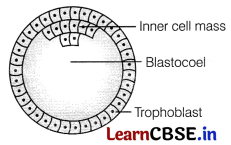
Question 70.
Describe the post-zygotic events leading to implantation and placenta formation in humans. Mention any two functions of placenta. (All India 2010)
Or
ExplainExplain the process of fertilisation in human female and trace the post-fertilisation events in a sequential order up to implantation of the embryo. (Foreign 2010)
Answer:
Post-zygotic events leading to implantation and placenta formation.
Refer to Answer No. 23 (i).
Events leading to formation of placenta and functions of placenta-Refer to Answer No. 24.
Question 71.
(i) Mention the event that induces the completion of the meiotic division of the secondary oocyte.
(ii) Trace the journey of the ovum from . the ovary, its fertilisation and further development until the implantation of the embryo. (All India 2010C)
Answer:
(i) Secondary oocyte completes meiosis-II only
when a sperm enters into its cytoplasm. It forms a larger cell, the ootid and a small cell, the second polar body.
(ii) (a) The secondary oocyte is released by the rupture of the Graafian follicle in the process called ovulation.
(b) It is moved into the Fallopian tube with the help of fimbriae.
(c) It reaches the ampullary-isthmic junction of the Fallopian tube where fertilisation takes place.
(d) After fertilisation, cleavage starts in the zygote.
(e) Cleavage results in the formation of 2, 4, 8 and 16 daughter cells called blastomeres. The embryo with 8-16 blastomeres is a solid spherical structure called morula.
(f) Morula continues to divide and blastomeres rearrange themselves as it moves further into the uterus.
(g) As a result, blastocyst is formed, which contains trophoblast (outer layer) and inner cell mass.
(h) The trophoblast attaches to endometrium and blastocyst gets embedded in it (implantation).
Question 72.
Draw a diagrammatic sectional view of the female reproductive system of human and label the parts.
(i) Where does the secondary oocyte develop?
(ii) Which help in the collection of ovum after ovulation?
(iii) Where does fertilisation occur?
(iv) Where does implantation of embryo occur? (Delhi 2013)
Answer:
For diagram, refer to the figure 3.2 on page no. 48.
(i) The secondary oocyte develops in ovary.
(ii) Fimbriae help in the collection of ovum after ovulation.
(iii) In the junction of ampulla-isthmus, the ovum gets fertilised.
(iv) Implantation of embryo occurs in the cavity of uterus.
Question 73.
Write the function of each one of the following
(i) Fimbriae (oviducal)
(ii) Coleoptile
(iii) Oxytocin (Delhi 2012)
Answer:
(i) Fimbriae are the feathery finger-like projections present at the end of Fallopian tubes. They help to collect the ovum after its release from the ovary during ovulation.
(ii) Coleoptile is a conical sheath present in the monocot seeds and its function is to protect the developing plumule.
(iii) Oxytocin is a hormone secreted by the posterior pituitary that stimulates the contraction of uterine muscles during child birth (parturition).
Question 74.
Write the function of each of the following
(i) Middle piece in human sperm
(ii) Tapetum in anthers
(iii) Luteinising hormone in human males (Delhi 2012)
Answer:
(i) Middle piece in human sperm contains several mitochondria which produce energy for the motility of the sperm.
(ii) Tapetum in anthers It is the innermost layer of the anther. The main function of tapetum is to provide nourishment to the developing pollen grains.
(iii) Luteinising hormone in human males stimulates the Leydig cells to produce testosterone which is necessary to complete the process of spermatogenesis.
Question 75.
Write the function of each of the following
(i) Seminal vesicle
(ii) Seutellum
(iii) Acrosome of human sperm (Delhi 2012)
Answer:
(i) Seminal vesicle During spermatogenesis, it secretes an alkaline fluid rich in fructose and prostaglandins. High level of fructose provides energy to sperms.
(ii) Scutellum It is a tissue present in seed to absorb food from the adjacent endosperm and develops into growing embryo.
(iii) Acrosome of human sperm It is the cap-like structure that is present at the tip of the sperm (male gamete) in head region. The acrosome contains hydrolytic enzyme, which helps the sperm to enter into the cytoplasm of the ovum and thus, helps in fertilisation.
![]()
Question 76.
Give reasons for the following
(i) The human testes are located outside the abdominal cavity.
(ii) Some organisms like honeybees are called parthenogenetic animals. (All India 2012)
Answer:
(i) Testes are located outside the abdominal cavity within a pouch called scrotum. It maintains low temperature of the testes (2-2.5°C lower than normal body temperature) required for spermatogenesis.
(ii) In honeybees, the drone bees are developed parthenogenetically from an unfertilised egg. Since, they develop from unfertilised diploid eggs (and do not undergo fertilisation), they are called parthenogenetic animals.
Question 77.
(i) Explain the following phases in the menstrual cycle of a human female.
(a) Menstrual phase
(b) Follicular phase
(c) Luteal phase
(ii) A proper understanding of menstrual cycle can help immensely in family planning. Do you agree with the statement? Provide reasons for your answer. (All India 2017)
Answer:
(i) (a) Menstrual phase The menstrual cycle starts with menstrual phase. It lasts for about 3-5 days. The menstrual flow results due to the breakdown of endometrial lining of the uterus and its blood vessels that gome out through vagina.
(b) Follicular phase It lasts till about 13th day of menstrual cycle. In this phase, the primary follicles in the ovary grow to become a fully mature Graafian follicle. The secretion of gonadotropins (LH and FSH) from anterior pituitary increases gradually during the follicular phase. They stimulate follicular development as well as secretion of oestrogen by the growing follicles.
(c) Luteal phase This phase lasts for about 10-14 days. In this phase, the ruptured Graafian follicle transforms into corpus luteum. It secretes large amount of progesterone which is essential to maintain endometrium.
During
Question 78.
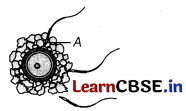
(i) One of the sperms is observed to penetrate ‘A’ of the ovum, as shown in the above diagram. Name ‘A’.
(ii) How is the sperm able to do so?
(iii) Where exactly in the Fallopian tube does this occur?
(iv) Explain the events thereafter up to morula stage. (All India 2013C)
Answer:
(i) A is zona pellucida.
(ii) Sperm is able to penetrate the egg with the help of sperm lysins contained in acrosome.
(iii) Ampullary-isthmic junction.
(iv) As soon as the sperm enters the egg, meiotic division of secondary oocyte gets completed. As a result a second polar body and a haploi ovum are formed. Then, haploid sperm and ovum fuse together to form a diploid zygote which undergoes cleavage via mitotic division. At 8-16 cell stage, the embryo is called morula.
Question 79.
(i) Draw a labelled diagram of the human female reproductive system.
(ii) Enumerate the events in the ovary of a human female during
(a) follicular phase
(b) luteal phase of menstrual cycle (Delhi 2012)
Answer:
(i) Refer to figure 3.2 on page no. 49.
(ii) (a) Follicular phase The primary follicle in the ovary grows to become fully mature Graafian follicle. Endometrium gets thickened and the follicular cells secrete oestrogen.
(b) Luteal phase The remaining part of ruptured Graafian follicle transforms into corpus luteum that secretes progesterone.
Question 80.
(i) Write the specific location and the functions of the following cells in human males
(a) Leydig cells
(b) Sertoli cells
(c) Primary spermatocytes
(ii) Explain the role of any two accessory glands in human male reproductive system. (Delhi 2011)
Answer:
(i) Refer to Answer No. 2 of Topic 1.
Primary spermatocytes are located inside the seminiferous tubule and are involved in the formation of spermatozoa.
(ii) Accessory glands of human male reproductive system are
(a) Prostate and seminal vesicles Their secretions provide a fluid medium for the sperms to swim towards the ovum. They provide nutrition to sperms.
(b) Bulbourethral glands Their secretion helps in the lubrication and neutralising the acidity of urogenital tract.
Question 81.
(i) When does oogenesis begin?
(ii) Differentiate between the location and function of Sertoli cells and Leydig cells. (All India 2010)
Answer:
(i) Oogenesis begins during the embryonic development stage when a million gamete mother cells (oogonia) are formed within each foetal ovary.
(ii) (a) Sertoli cells are located on the inside lining of seminiferous tubule. These cells provide nutrition to the germ cells.
(b) Leydig cells or interstitial cells are located in the regions outside the seminiferous tubule called interstitial spaces. These cells synthesise and secrete testicular hormone called androgens.
Question 82.
Smita was studying in class 6th. Her mother wanted to tell her daughter about the menstrual cycle. Was she correct in doing so?
Answer:
Smita’s mother was correct as it is necessary to inform girls about the onset of menstrual cycle, so that they do not misunderstand it. It shows the care and responsibility cf mother towards her daughter.
![]()
Question 83.
Charu got pregnant with her first baby. She asked her husband (who is a doctor) to know about the changes which would take place in her body during pregnancy.
(i) What is implantation?
(ii) What values does the Charu’s husband show?
Answer:
(i) The implantation is the embedding of the blastocyst in the endometrium of the uterus.
(ii) Being a doctor, Charu’s husband shows positive attitude towards her wife’s and he should provide step by step explantation for her queries.
Question 84.
Rita was 9 months pregnant, she wanted to know that how the foetus gets delivered after the human pregnancy period. So, she asked her gynaecologist to explain it to her, so that she can mentally prepared for her delivery. Her gynaecologist explained to her about the process in a very precise manner.
(i) What is the average duration of human pregnancy known as?
(ii) What is the term given to the process of delivery of foetus?
(iii) What are the values exhibited by Rita’s gynaecologist?
Answer:
(i) The average duration of human pregnancy is called as gestation period. It is approximately 270 days in humans.
(ii) The term given to the process of delivery of foetus is called parturition.
(iii) Rita’s gynaecologist has a scientific temper and patience to deal with her patients.